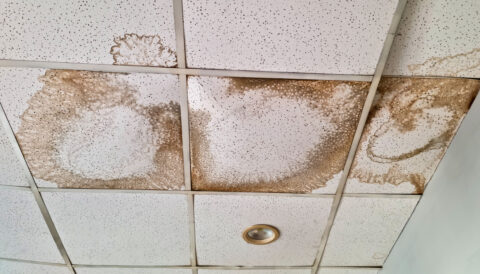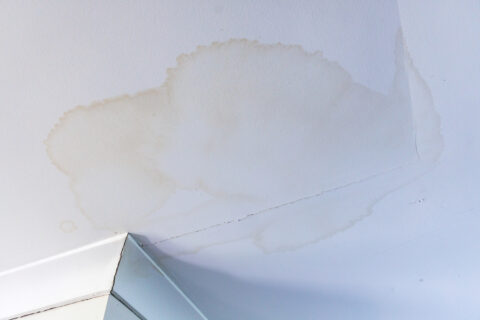
So do you need to replace a ceiling when it gets wet? Not necessarily. Here is a guide to help you figure out when your ceiling needs to be replaced after getting wet.
What Water Damage Looks Like on a Ceiling
You may not spot water damage on your ceiling immediately. Depending on how fast the water is flowing, and what your ceiling is made of, it may take time for water to seep through. Plus, some signs of water damage become more visible after the water has dried. Here are some of the signs of water damage to look for:
- Discolored ceiling: may be off-white, yellow, rusty brown, or black
- Peeling or bubbling paint
- Popcorn texture falling off
- Sagging drywall
- Bulging drywall
- Cracks in the ceiling
- Mold growth
A discolored ceiling is often the easiest sign of water damage to spot. The discolored ceiling may be many colors depending on the source of the water and the nature of your ceiling. Clean water might just make the wet part of the ceiling look a little off, with a darker outline around the damaged area. Water passing along pipes might bring rust with it, and dirty water might leave a black residue.
A painted ceiling might conceal old water damage, but as long as the water is flowing, the paint will reveal its presence by peeling or bubbling. Water damage can also cause popcorn texture to fall off the ceiling.
Drywall loses strength when it gets wet, so it can start to sag. It also expands when wet, which can make it bulge.
When drywall gets wet and swells, then dries, it can form cracks. These cracks might be small, but sometimes they can be large. You might need a professional to tell you the difference between cracks from water damage and cracks from a settling structure.
Water can also trigger the growth of mold on the ceiling just like it can trigger it on the walls. This often looks like flowery or lacy patterns in green, gray, or black.
When a Ceiling Needs to Be Replaced
Sometimes there’s enough water damage that all or at least part of your ceiling needs to be replaced.
Ceiling Tiles Discolored

Cut the flanges that interlace between the tiles and pull down the impacted tiles. Assess the amount of water above the ceiling. If the insulation is soaked, pull it down. Also note whether the ceiling joists are damp, and if they have signs of repeated moisture, such as small amounts of mold or mildew, even if it’s dry. Inspect the entire path between the wet tiles and the water source.
Cut away the flanges on the new tiles as necessary and apply adhesive to the back of the tiles. Hold them in place until the adhesive sets.
Drywall Starts to Sag
If you have a drywall ceiling, you will need to replace it at least partially when the drywall begins to sag. Sagging drywall has lost its structural integrity. Even once dried, it is likely to collapse.
Rather than having a saggy piece of drywall at risk of collapse at any time, it’s best to replace it immediately. Besides, this allows you to assess the amount of water damage above the ceiling. Look for signs of mold or mildew above the drywall. Inspect the entire path between the source of the water and the wet drywall patch.
Cut out the affected area. If it’s not a large patch, make sure that you can secure it, ideally to at least one joist.
Structural Drying Above the Ceiling
Sometimes you have to remove a ceiling not just because of the damage to the ceiling, but because of the potential damage above the ceiling. If there’s significant moisture above the ceiling, you might need to remove the ceiling to make sure you can get enough airflow to dry the joists. If you don’t properly dry the joists, water damage will weaken them, which could lead to the collapse of the whole ceiling and/or floor.
Whenever your joists are wet, it’s critical to start drying immediately to head off or stop water damage.
Dirty Water Damage
When your ceiling was damaged by dirty water, such as flood water, backed up sewer water, an overflowing toilet, or others, then you should replace it. Leaving the ceiling in place creates a risk that the ceiling could be a source of contamination to your home.
When to Get a Professional for Ceiling Water Damage

You should always get a water damage restoration professional to handle ceiling water damage if:
- You can’t find the source of water
- Joists are wet
- Water damage happened over time
- The damage is from dirty water
- You don’t have the equipment or skills to replace ceiling
The most important thing about controlling water damage is identifying and stopping the source of water. If you can’t find the source of water that damaged your ceiling, bring in a professional who can. Otherwise, you will experience more wet ceilings that will get worse over time.
Wet drywall or ceiling tiles are one thing. Wet joists are another. When your joists get wet, water damage will begin to weaken them as microorganisms attack the wood. The likelihood of damage increases over time as repeated moistening of joists encourages more wood rot. If you have wet joists, it’s important to start drying immediately to control structural damage.
You should also call out a water damage restoration professional if dirty water damaged your ceiling. A professional can assess the risk of contamination posed by the specific water that impacted your ceiling.
You also need to be sure that you can handle the repair or replacement of your ceiling material. Ceiling tiles are relatively easy to replace, but drywall is heavy and a drywall ceiling can be hard to secure if you don’t have experience working with it. Even a small patch of drywall will have to be smoothed and blended with the ceiling. If inexpertly done, a patched area of drywall is very obvious. If you’ve never patched drywall before, consider getting a professional to handle this highly visible location.
Ceiling Restoration in Billings Metropolitan area
If your ceiling suffered water damage in Billings Metropolitan area, Alpha-Omega Distaster Restoration can help. Our restoration experts are prepared to help with any type of water damage, from the simple replacement of a few ceiling tiles to structural drying of the entire ceiling and a full drywall replacement. Alpha-Omega Damage Restoration Experts has been the leading restoration company in Billings Metropolitan area since 2006. We offer 24/7 emergency response services so we can be on hand to start work on your ceiling immediately. With our meticulous process and updated methods and technology, we can stop the progress of water damage, preserving your building’s structural integrity whenever possible.
If you want to make a claim with your insurance company, we can coordinate the claim directly with them to make the process as smooth as possible. Our thorough documentation of the original damage and any work performed will give your insurance company all the information that they need to pay your claim quickly and to the full extent of your coverage.
To learn how Alpha-Omega Damage Restoration Experts can repair your ceiling, please contact us at 406-628-0178 today. We serve customers in Billings Metropolitan area.
